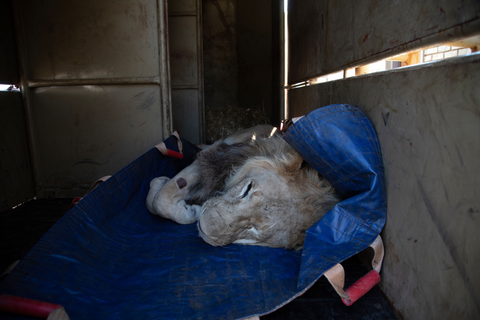GEORGES — A Lion's Tale. Lion Rescue from Canned Hunting


for the bullet in South Africa. Whilst leaving we noticed a lonely lion with
a crooked tail, Georges. We vowed to come back to rescue him before
he too ended up as a trophy hunt and later his bones sent to Asia to be
used in traditional but ‘bogus’ Medicines.
rescue Georges, we found ourselves in the midst of the global pandemic
Covid-19 and our team could not travel to take him to safety.
On top of the Covid situation, the Sanctuary he was going to did not make
the necessary plans to rescue him on their end. So, we found a new
ethical placement for him. Whilst preparing Georges Permits,
we became aware of 3 more lioness in dire need. Wild at Life decided to
rescue them all, leaving no one behind.

Asli Han Gedik arrived into South Africa to rescue Georges, Julie, Eva and
Elma.
whilst he awaited his imminent slaughter.
But Georges was born with a fault; his tail was crooked and he was
therefore discarded as a future trophy’s, instead he was to be
slaughtered just for his bones!

On the morning of the rescue — as dawn-broke — Wild at Life and their Veterinarian entered the Lion farm, they then successfully darted(Sedated) Georges, Eva, Elma and Julie inside their stark enclosures.
Once sedated, the lions were all then carefully lifted out one-by-one by our team of six and placed onto their waiting transport.


Our big Cat veterinarian proceeded to reverse the sedative and gave an immune booster too.


We made frequent stops on roadside to check up on their well-being.
They all slept nicely.
Finally arriving at the Sanctuary, Julie was the first out of the trailer.
Julie was first to explore
The first thing she did was to climb a tree – something she had never touched before.

The pride’s new sanctuary features plenty of features that would be found in their natural habitat, tall grass to relax in and an array of Acacia, Jackal berry and Marula trees to offer shade and enrichment.
As lions possess interdigital glands, they are use the trees to transmit a scent when flexing their toes, which aids in territorial marking and other types of olfactory messaging to one another.
Georges, Julie, Elma and Eva will now live as part of a pride for the first
time in their lives free from the threat of a bullet.

George, Eva, Elma and Julie are symbols of hope in our campaign against canned lion hunting.


Dejar un comentario